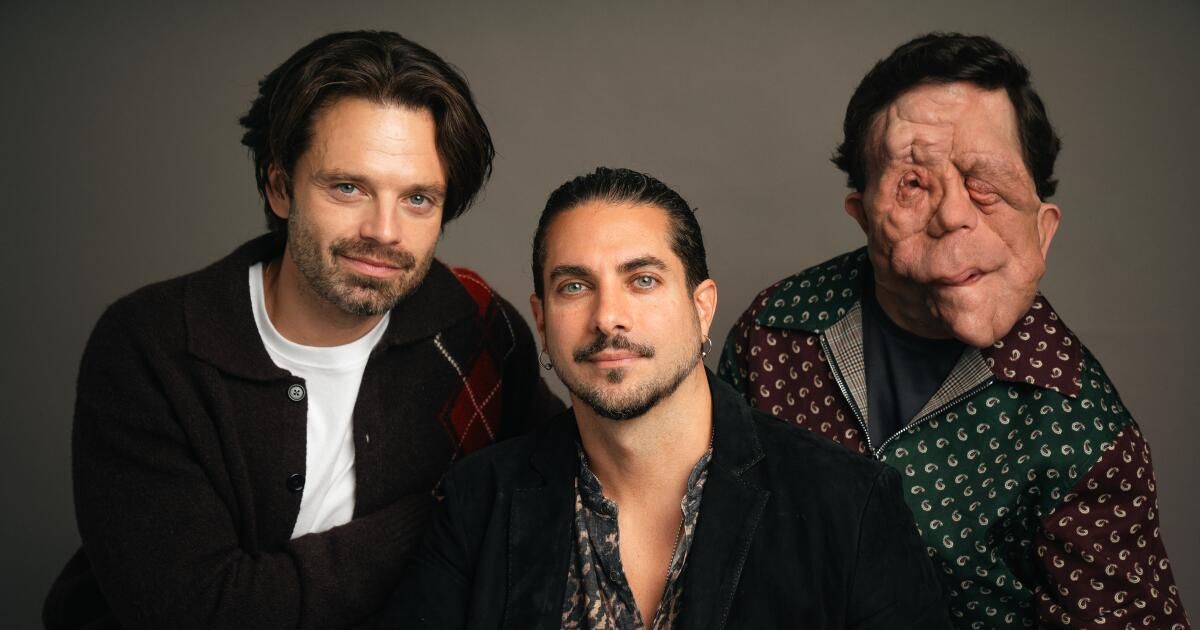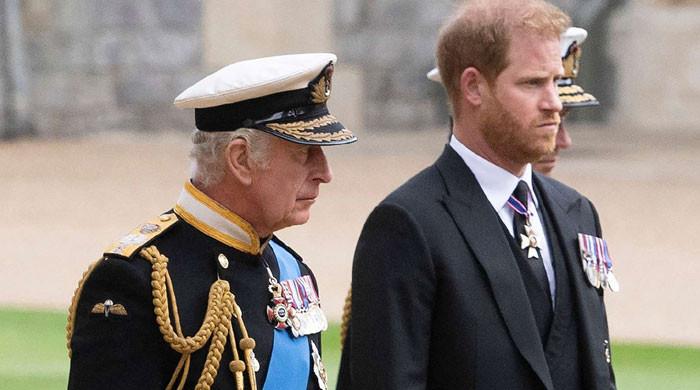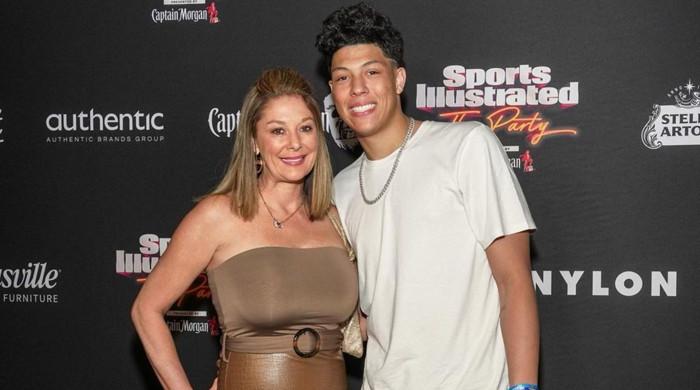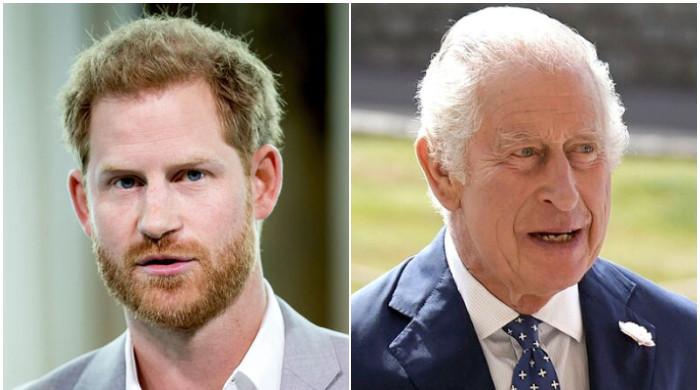At the tender age of 5, Mike Marino saw “The Elephant Man” for the first time and his life was forever changed. When David Lynch’s haunting and heartbreaking tale of the disfigured John Merrick aired on HBO in the early 1980s, Marino was horrified but unable to look away, sparking a fascination with prosthetics that would eventually lead him to become one of Hollywood’s top makeup artists.
“I was so scared, but I didn’t know how beautiful that story was and the imprint it would leave on my brain and my soul,” says Marino, 47, who earned back-to-back Oscar nominations in 2022 and 2023 for his makeup work on “Coming 2 America” and “The Batman,” the latter starring a fully transformed Colin Farrell. “If it wasn’t for that movie, I wouldn’t be doing what I’m doing.”
But for actor, TV host and disability rights advocate Adam Pearson, Lynch’s film took on a more painful role in his life. Pearson, who grew up in England with neurofibromatosis type 1, a rare genetic disorder that causes tumors to grow on his face, was often teased by his classmates, who cruelly called him “the Elephant Man” and other nicknames. As he grew older, he saw how movies routinely portrayed people with disfigurements as freaks, villains or victims, stripping them of their humanity. “There’s an element of laziness to it,” says Pearson, 39. “How do we show this character is evil? Let’s scar him.”
Now, by a twist of fate, Marino and Pearson’s lives have intersected on a very different project: the darkly funny, mind-bending psychological thriller “A Different Man.” Directed by Aaron Schimberg, the A24 film stars Sebastian Stan as Edward, a shy, disfigured actor working in New York City who undergoes an experimental procedure to transform his appearance, only to find that he loses the role he was born to play (himself) to a cheerful, outgoing man named Oswald with the same facial deformity, played by Pearson. Renate Reinsve (“The Worst Person in the World”) co-stars in the film as a playwright whose latest work brings Edward’s identity crisis to a head.
Renate Reinsve and Sebastian Stan in the film “A Different Man”.
(Matt Infante / A24)
“A Different Man,” which The Times called “a self-deconstructive, meta-pretzel black comedy” upon its debut at this year’s Sundance Film Festival, tackles complex themes of identity, beauty and disability with a mix of Charlie Kaufman-style surrealism and David Cronenberg-style body horror. Along with Stan’s performance, Marino’s meticulously crafted prosthetics are key to bringing Edward and his inner agonies to life, reflecting the deeper emotional anguish of a man trying to escape his own skin.
“The film shows how the shell of who we are should not determine our spirit and our personality,” Marino says. “I think it is a very important film, like 'The Elephant Man' was.”
When Schimberg first wrote the script — inspired by his own struggles with cleft palate and his experience working with Pearson on his 2019 satire “Chained for Life” — he initially had no idea how he would manage to pull off the film’s demanding prosthetic work. “I was kind of blissfully ignorant,” Schimberg says. “After Sebastian came on board, we started improvising the film very quickly. It was only a month before shooting that I realized this movie would completely fall apart if we didn’t get this right. It was very difficult.”
When he came on board as an executive producer on the film, Stan asked if there were any makeup artists in the New York area who could handle such a difficult job under such time pressure. The answer was always the same: “Literally, everyone, without exception, was like, ‘You have to hire Marino,’” the actor recalls.
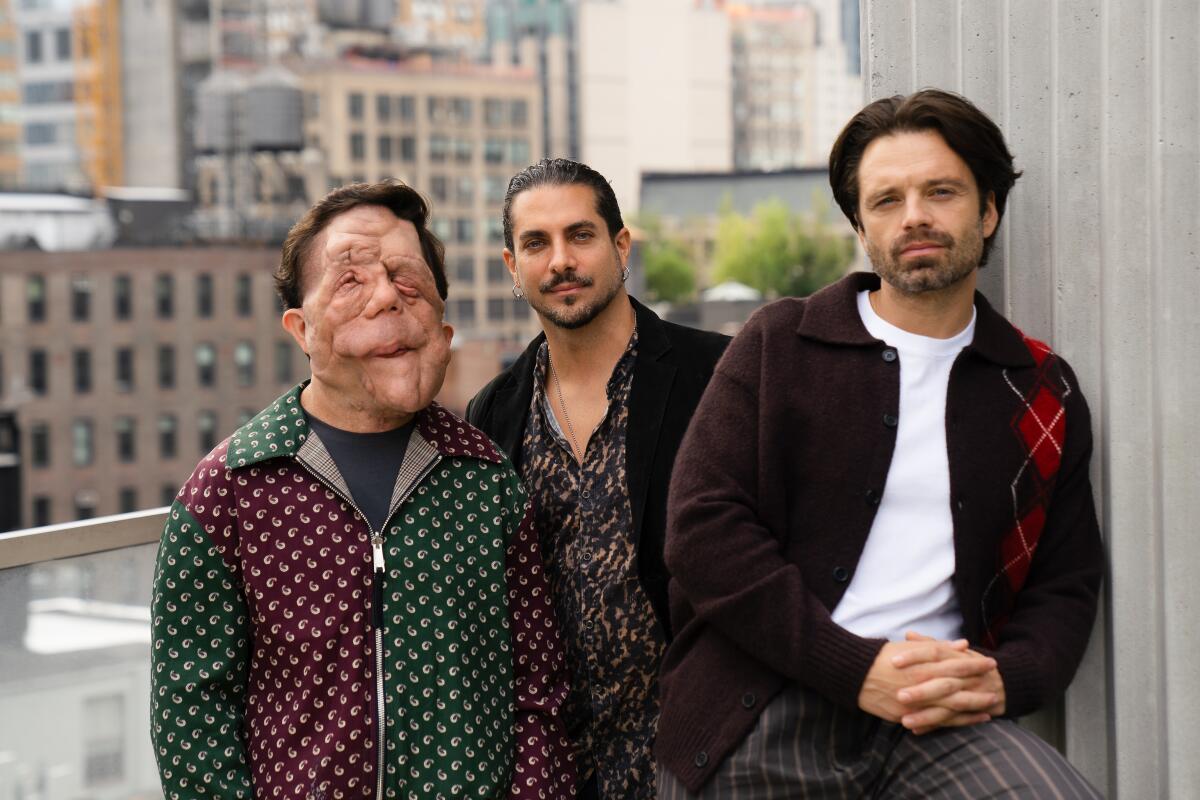
Pearson, left, Marino and Stan, photographed at the A24 offices in New York City in September.
(Sean Dougherty/For The Times)
Though already busy with work on “The Marvelous Mrs. Maisel,” Marino, who has done his share of more fantastical creatures, took on the challenge of recreating a real-life disfigurement like Pearson’s. “I’m fascinated by people who have something on their skin because it’s the most interesting, artistic and natural thing,” Marino says. “To me, there’s an amazing beauty in Adam’s look. It wasn’t a scary face or a monstrous person. I don’t like doing things like that that have no soul or purpose.”
Marino’s passion for makeup and prosthetics took root at an early age, inspired by industry legends like Dick Smith (“The Exorcist”) and Rick Baker (“An American Werewolf in London”). Marino, who grew up in New York, began honing his skills as a preteen by practicing on his friends with latex, foam and various chemicals, destroying his bedroom carpet in the process, much to the chagrin of his parents. While still in high school, he mailed his portfolio to Smith and received encouragement and advice over the phone from the makeup legend, who won an Oscar in 1985 for “Amadeus” and received an honorary Academy Award for his lifetime of work in 2012. “Once he recognized me, I was like, OK, this is serious. There was no stopping me.”
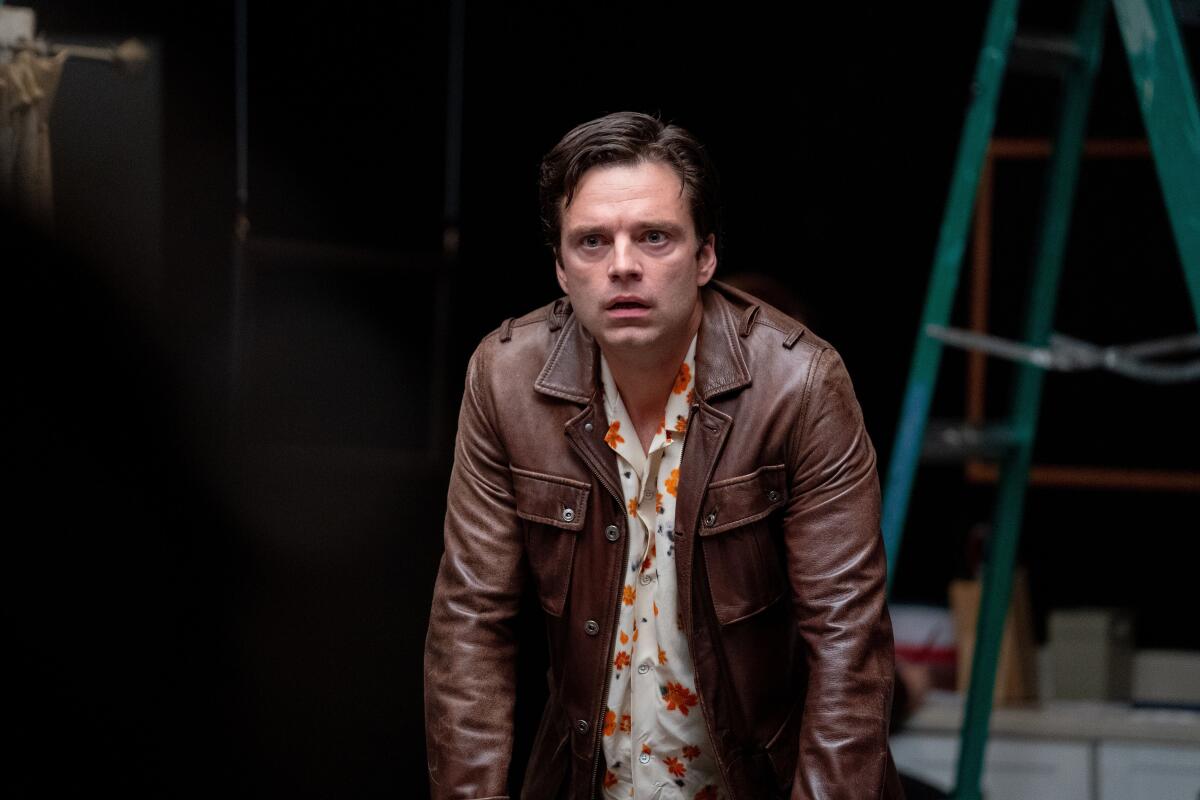
After undergoing an experimental treatment to change his face, Edward (Sebastian Stan) adopts an alter ego named Guy.
(A24)
After cutting his teeth on “Saturday Night Live” and “Buffy the Vampire Slayer,” Marino broke into the film world with the 2007 psychological thriller “Anamorph” and quickly became known for his versatility, seamlessly switching between fantastical creatures and more subtle, realistic applications. His work on Darren Aronofsky’s “Black Swan” amplified the film’s psychological horror, while on Martin Scorsese’s “The Irishman,” he enhanced the digital de-ageing of Robert De Niro and Al Pacino with carefully crafted prosthetics.
Outside of film, Marino created The Weeknd’s plastic surgery-gone-wrong look for the singer’s “Save Your Tears” music video. “These are problems that need to be solved,” Marino says. “There’s no playbook.”
In “A Different Man,” Marino used photographs and 3-D scans of Pearson’s face — he underwent about 40 surgeries over the years — as the basis for a multi-piece silicone prosthesis that would work with Stan’s features. “There was no way I could completely replicate Adam’s exact proportions,” he says. “I had to make some aesthetic decisions.”
While the makeup work on “The Elephant Man” benefited from that film’s grainy black-and-white cinematography, the prosthetics on “A Different Man” had to endure more relentless scrutiny. To test his Edward visage, Stan walked from Marino’s makeup chair to the set through the streets of New York and crowds of strangers, giving him tremendous insight into how people treat those who look different.
“I went to my old coffee shop and the same barista who had served me for years couldn’t identify me,” Stan recalls. “I could feel people’s reactions in real time. There were people who couldn’t even look at me, others would stare, and sometimes the reaction was stronger, like, ‘Oh shit, it’s the Elephant Man! ’ As Adam says, you feel like you’re public property.”
Pearson, who shares his character’s cheerful sociability, encouraged Stan to think about it as he does his own experience as a movie star. “I said, ‘You don’t know the level of invasion I get when people point at me and stare at me and take pictures of me, but you do understand something very similar from this angle, so go into that,’” he says. “And if it makes you uncomfortable, go into it further.”
While wearing the prosthetics, Stan could only see out of one eye and had limited hearing in one ear — challenges that helped shape his performance as a man who has learned to avoid potential threats and insults. “Edward is a character who has had to endure a lot of emotional abuse and probably physical abuse as well, so he’s probably always a little on his left foot in case something happens,” Stan says.
As Edward's face changes after his radical treatment, Marino made additional prosthetics that show the transition, including an “extremely soft, squishy version” that, in one particularly Cronenbergian scene, Stan could achieve in chunks.
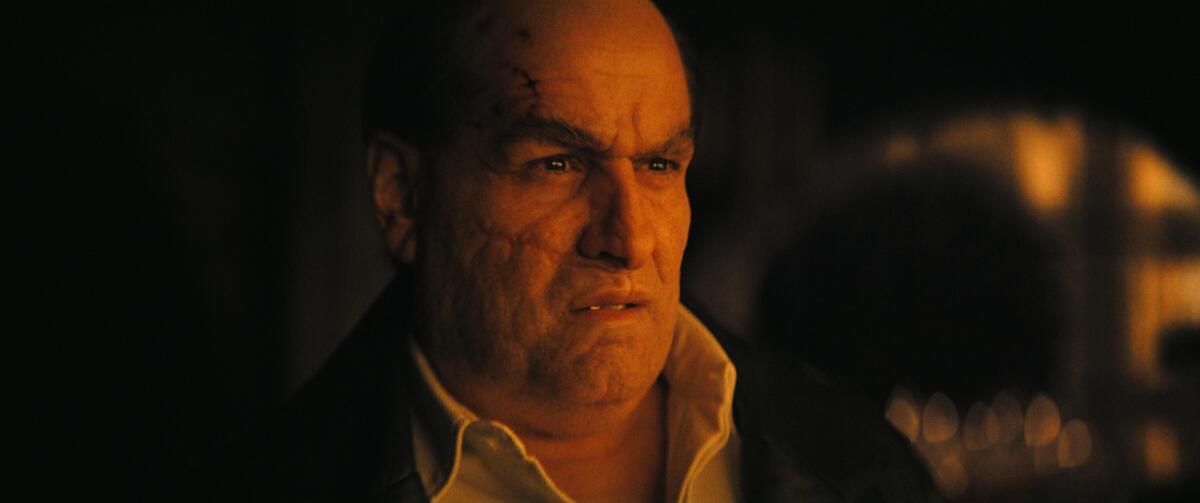
Colin Farrell as Oswald Cobblepot in “The Batman,” for which Marino was nominated for an Oscar.
(Photographs by Warner Bros.)
Marino’s talent for transforming stars is on full display in Farrell’s hulking, thuggish look as the Penguin in 2022’s “The Batman” and the new HBO spinoff series. “When Colin saw the sculpture I made, the ideas started popping,” Marino says. “Once we did a makeup test, it was magic — he could talk, he could walk, and he was the guy.”
Marino, who is preparing to make his directorial debut based on a script he wrote set in the 1980s (“There aren’t many effects,” he hints), has lost none of his passion for the transformative power of latex and silicone since his days as a teenager obsessively flipping through issues of Cinefex magazine. “If you think of Michelangelo showing beauty 500 years ago in paintings and sculptures, I’m still showing that same beauty, but in this new hyperrealistic way, in silicone,” says Marino, who named his makeup effects studio Prosthetic Renaissance. “It’s a very unique art. It’s like moving sculptures and paintings at the same time.”
As for Pearson, he says that if he were offered an experimental treatment to change his face, like in “A Different Man,” he wouldn’t take it. Despite the challenges it has brought him, Pearson believes his face has shaped the life he leads today.
“I joke with my friends that my disability is a deciding factor in my horrible personality,” she laughs. “Everyone thinks it’s hard to go from not having a disability to having one, but I think the opposite would be even harder. The journey we take and the struggles we go through make us who we are and they are inseparable from each other.”

